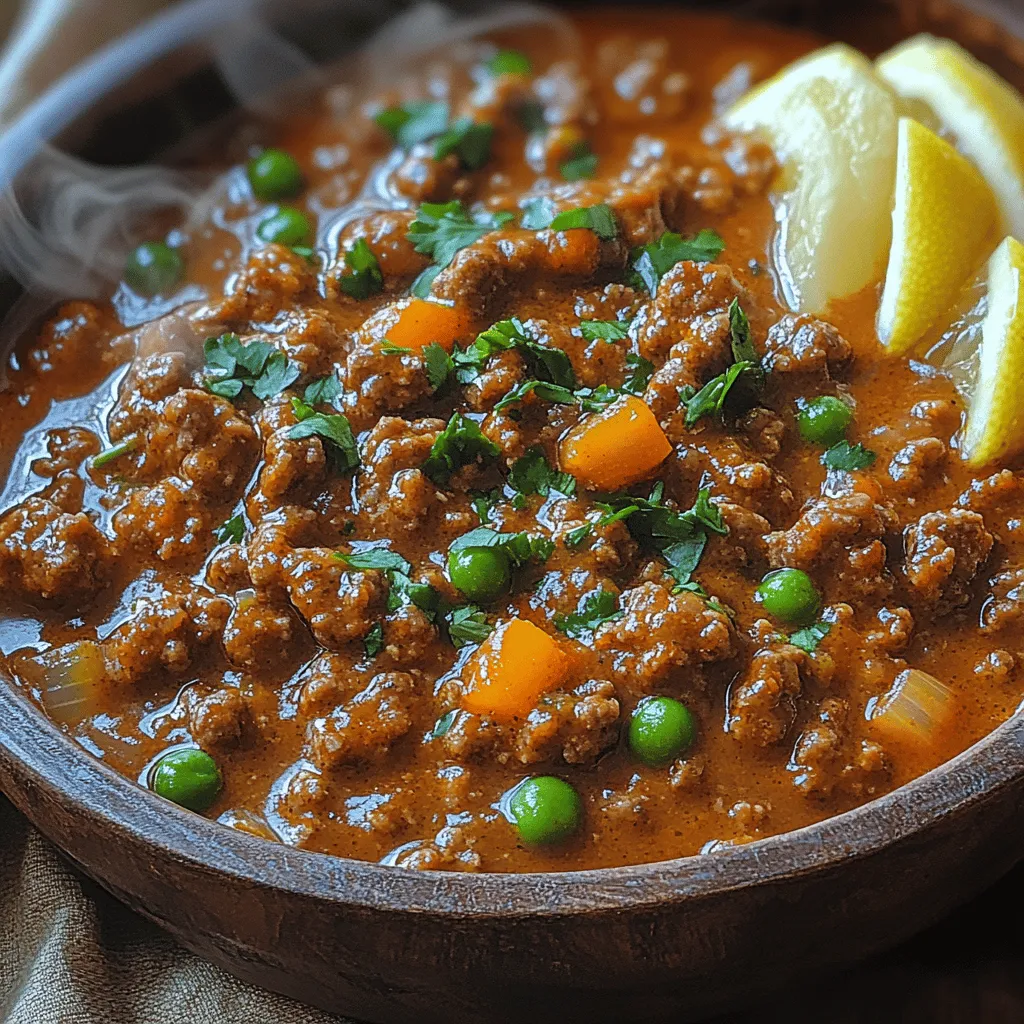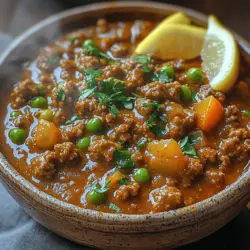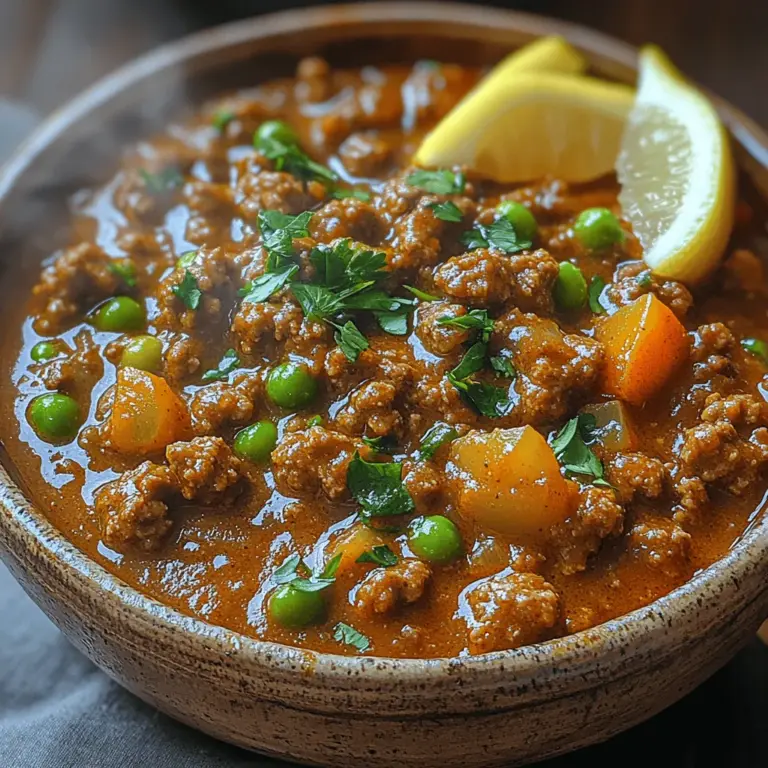Introduction
Qeema, a quintessential dish in Indian and Pakistani kitchens, is a beloved staple that showcases the rich tapestry of flavors characteristic of South Asian cuisine. Often made with ground meat—typically beef, chicken, or lamb—Qeema is renowned for its hearty, comforting nature, making it an essential part of family gatherings and festive occasions. The magic of Qeema lies in the harmonious blend of spices, which not only elevate its taste but also reflect the cultural significance of Indian cooking, where spices are not just ingredients but storytellers of heritage and tradition.
In the world of Indian cuisine, spices play a pivotal role, transforming simple ingredients into aromatic masterpieces. Savory Qeema is no exception, boasting a symphony of flavors that tantalize the taste buds while providing nourishment. This recipe is not merely about cooking; it’s about creating a dish that resonates with culinary traditions and brings warmth to the dining table. Whether you are an experienced cook or a novice eager to explore the depths of Indian flavors, this Qeema recipe is perfect for you. It’s simple yet sophisticated, and once you master it, your family and friends will surely be asking for seconds.
Understanding Qeema
What is Qeema?
Qeema, derived from the Urdu word for ‘minced’, refers to ground meat that is cooked with a medley of spices and vegetables. This dish is deeply embedded in the culinary cultures of India and Pakistan, where it holds a special place in everyday meals as well as celebratory feasts. Often served with naan, rice, or parathas, Qeema is versatile and can be adapted to suit various palates, making it a favorite among many.
Cultural Significance of Qeema
In South Asian households, Qeema is more than just a meal; it symbolizes comfort and togetherness. It is a dish that brings families together, often prepared in large quantities for gatherings and special occasions. The variations of Qeema reflect regional preferences and availability of ingredients, showcasing the diverse culinary landscape of the Indian subcontinent. Each region has its own unique twist on Qeema, be it the addition of local spices or the choice of meat, which further enriches its cultural significance.
Nutritional Benefits of Ground Beef
Ground beef is a fantastic source of high-quality protein, essential for muscle development and overall health. It is also rich in vital nutrients such as iron, zinc, and B vitamins, which are crucial for energy production and maintaining a healthy immune system. Incorporating ground beef into your meals can be a delicious way to ensure your family receives the nutrients they need, making Qeema not only a flavorful dish but also a nutritious one.
Ingredients Breakdown
Detailed List of Ingredients
To create the perfect Savory Qeema, it is essential to gather the right ingredients. Each component plays a significant role in developing the dish’s rich flavors and textures. Here’s a comprehensive breakdown of what you’ll need:
– Ground Beef: The primary ingredient that serves as the protein source and flavor base. It provides a hearty texture that pairs beautifully with spices.
– Spices: The heart of Indian cooking, a mix of spices is essential for creating depth of flavor in Qeema. You’ll need:
– Cumin Seeds: Adds an earthy flavor that forms the foundation of the dish.
– Coriander Powder: Provides a citrusy, nutty flavor that enhances the overall taste.
– Garam Masala: A blend of spices that adds warmth and complexity to the dish.
– Turmeric: Offers a subtle bitterness and is known for its anti-inflammatory properties.
– Red Chili Powder: Introduces heat and color, allowing you to adjust the spice level to your preference.
– Aromatics: Crucial for building flavor, you’ll use:
– Onion: Sautéed to golden perfection, it provides sweetness and depth.
– Garlic: Adds aromatic richness and enhances overall flavor.
– Ginger: Offers a warm, spicy note that complements the other ingredients.
– Green Chilies: Provides heat and freshness; you can adjust the quantity based on your spice tolerance.
– Vegetables:
– Tomato Puree: Contributes acidity and sweetness, balancing the spices.
– Frozen Peas: Adds a pop of color and sweetness, enhancing the dish’s texture.
– Garnishes:
– Fresh Coriander: Brightens the dish with its herbal notes and adds a fresh contrast.
– Lemon Wedges: A squeeze of lemon at the end elevates the flavors and adds brightness.
Preparation Steps
Now that you have gathered all the ingredients, it’s time to dive into the preparation of Savory Qeema. Follow these step-by-step instructions to ensure a successful cooking experience.
Step 1: Heating Oil and Toasting Cumin Seeds
Begin by heating a generous amount of cooking oil in a large skillet or heavy-bottomed pan over medium heat. Once the oil is hot, add a teaspoon of cumin seeds. Toasting the cumin seeds in hot oil will release their essential oils, enhancing their flavor and aroma. Stir them occasionally until they turn a deep golden brown, being careful not to burn them, as this can lead to a bitter taste.
Step 2: Sautéing Onions to Achieve the Perfect Golden Color
Next, add finely chopped onions to the pan. Sauté the onions over medium heat, stirring frequently, until they turn golden brown. This process may take about 10-15 minutes, but don’t rush it; achieving the right color is key to developing a sweet, caramelized flavor that forms the base of your Qeema. If the onions start to stick, add a splash of water to help deglaze the pan and prevent burning.
Step 3: Adding Garlic, Ginger, and Green Chilies for Aromatic Depth
Once the onions are perfectly caramelized, it’s time to introduce the aromatics. Add minced garlic, grated ginger, and finely chopped green chilies to the pan. Stir them in and sauté for about 2-3 minutes until fragrant. This combination will create a wonderful base that enhances the overall flavor profile of the dish.
Step 4: Incorporating Spices and Their Importance in Flavor Development
The next step is crucial for building the flavor of your Savory Qeema. Reduce the heat to low and add the ground spices: coriander powder, turmeric, red chili powder, and garam masala. Stir continuously for about a minute, allowing the spices to bloom and release their full flavor. This process is vital, as it melds the spices with the onion mixture, creating a robust foundation for the Qeema.
As you follow these steps, your kitchen will be filled with enticing aromas, hinting at the delicious meal that is about to unfold. With each ingredient contributing its unique profile, you are well on your way to mastering this traditional dish. Stay tuned for the next part, where we will delve deeper into the cooking process and complete the Savory Qeema recipe!

Browning the Beef and Achieving the Right Texture
The success of Savory Qeema lies in the perfect browning of the beef. Start by heating your oil in a heavy-bottomed pan over medium-high heat. It’s essential to allow the oil to become hot enough so the beef begins to brown upon contact. This browning process is critical as it develops rich, deep flavors through a chemical reaction known as the Maillard reaction.
Once your oil is ready, add the ground beef in small batches. Overcrowding the pan can cause the meat to steam instead of brown, resulting in a less-than-ideal texture. Allow the beef to cook undisturbed for a few minutes before stirring it. This will help achieve that desirable browning effect. As the beef cooks through, break it apart with a wooden spoon to ensure even cooking. You want the beef to be browned and crumbly, not clumpy, providing the perfect base for your Savory Qeema.
Adding Tomato Puree and Balancing Flavors with Salt
With the beef browning beautifully, it’s time to add the tomato puree. This ingredient not only adds moisture but also balances the richness of the beef with its acidity. Pour in the tomato puree once the beef is browned, stirring it in thoroughly. Allow it to cook for about 5-7 minutes. This step helps to cook off the raw tomato flavor, allowing it to meld perfectly with the beef.
Next, it’s crucial to season your mixture with salt. Start with a teaspoon and taste as you go. Remember, the salt enhances the natural flavors of the beef and the tomatoes, creating a harmonious blend. Adjust the quantity based on your preference and the overall seasoning balance of the dish. This careful addition of salt is essential to elevate the dish, ensuring that each bite is flavorful without overwhelming the palate.
Stirring in Peas and Finishing Touches with Garam Masala
After the tomatoes have cooked down and incorporated well with the beef, it’s time to introduce the peas. Frozen peas work beautifully here; they require minimal cooking and add a lovely sweetness that contrasts nicely with the spiced meat. Stir in about a cup of peas and let them cook for an additional 3-5 minutes. The peas should be tender but still vibrant in color.
The final flourish in your Savory Qeema comes from the addition of garam masala. This spice blend is integral to Indian cuisine, adding warmth and depth. Sprinkle about a tablespoon of garam masala over the cooked mixture and stir it in. The heat will help release the spices’ essential oils, creating an inviting aroma that fills your kitchen.
Importance of Taste Testing and Adjusting Seasoning
As you near the completion of your Savory Qeema, taste testing is crucial. This is the moment to ensure the flavors are balanced and pleasing to your palate. Adjust the seasoning as necessary; if it feels a tad flat, consider adding a pinch more salt, a dash of chili powder for heat, or a splash of lemon juice for acidity. The goal is to create a well-rounded dish that bursts with flavor.
Cooking Techniques
Sautéing: Importance in Building Flavors
Sautéing is a fundamental cooking technique used throughout this recipe. The process of quickly cooking food in a small amount of fat at high heat helps develop complex flavors and textures. In Savory Qeema, sautéing the onions and spices at the beginning lays the groundwork for a flavor base that enhances the overall dish.
Browning Meat: Achieving Rich Flavors Through Maillard Reaction
Browning the meat is not just a step; it’s a technique that infuses your dish with savory depth. The Maillard reaction, which occurs when proteins and sugars in the meat react to heat, creates that delicious, caramelized crust that adds both flavor and aroma. This step is critical in achieving the authentic taste of Savory Qeema, highlighting the richness of the beef.
Simmering: Allowing Flavors to Meld Together
Simmering is another essential technique in this recipe. Once all your ingredients are combined, allowing them to simmer enables the flavors to meld together beautifully. This gentle cooking method allows for the development of an intricate flavor profile, ensuring that every bite of Savory Qeema is a delightful experience.
Serving Suggestions
Savory Qeema is a versatile dish that pairs wonderfully with various accompaniments. Traditional Indian breads, such as naan or roti, are ideal for scooping up the meaty mixture. These breads complement the dish’s spices and add a comforting element to the meal.
Rice options also abound. Consider serving Savory Qeema over basmati rice for an aromatic touch, or jeera rice (cumin rice) to enhance the dish’s flavors further. The fluffy rice acts as a perfect vehicle for the savory beef, creating a satisfying balance.
To elevate your meal, consider adding side dishes or salads. A simple cucumber raita, made with yogurt and diced cucumbers, offers a cooling contrast to the spiciness of the Qeema. Additionally, a fresh salad with tomatoes, onions, and a citrus dressing can provide a refreshing crunch that complements the dish beautifully.
Health Aspects of Savory Qeema
When it comes to nutrition, Savory Qeema is a hearty dish that offers a wealth of benefits. The primary ingredient, ground beef, is an excellent source of protein, essential for muscle growth and repair. A typical serving provides a substantial amount of iron, zinc, and B vitamins, which are crucial for overall health.
The addition of vegetables, such as peas and tomatoes, not only enhances the flavor but also contributes vital vitamins and minerals. Peas are a great source of fiber, which aids in digestion, while tomatoes provide antioxidants like lycopene, known for its health benefits.
While Savory Qeema is indulgent, it can be enjoyed in moderation as part of a balanced diet. Pairing it with whole grains or adding extra vegetables can enhance its nutritional profile, allowing you to savor the dish without guilt.
Conclusion
Savory Qeema is a delightful representation of the rich culinary heritage of Indian cuisine. With its spiced beef and vibrant flavors, this dish is perfect for gatherings, family dinners, or simply a comforting meal after a long day. Its versatility allows you to enjoy it in various ways, whether with traditional breads or rice, making it suitable for any occasion.
We encourage you to try making Savory Qeema at home for your family and friends. Not only will they appreciate the effort, but they will also enjoy the authentic flavors that come from your kitchen. Cooking is a joy, and sharing these experiences, especially with comforting dishes like Savory Qeema, creates lasting memories and connections. So gather your ingredients, embrace the process, and enjoy the wonderful world of cooking Indian flavors.

